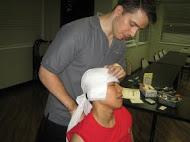
Head injuries refer to any kind of trauma that leads to injury of the brain, skull or the scalp. The injury can either be minor or serious injuries that damage the brain or even cause death. The injury can be open or closed depending on whether there is penetration of the skull. Closed head injury is when there is no penetration, while an open injury occurs when the skull is broken because of the impact leading to the injury. Some of the major causes of head injuries include traffic accidents, physical assault or accidents at home or while playing games. In order to give effective first aid you first need to know the symptoms involved. Some of the signs may be experienced instantly while others may take time.
Symptoms of Head Injuries
- Fracture of the skull
- Swelling or bleeding of the skull
- Pain in the spinal cord especially near the head
- Concussions
By understanding the symptoms, you will be in a position to offer effective first aid. It is important to call for medical help if the victim shows the following symptoms.
- Abnormal behavior
- Stiff neck
- Excessive vomiting
- Lose of consciousness
- Unable to move leg or arm or
- Gets sleepy.
You can also apply the following first aid steps.
- Call emergency service provider or 911.
- If the person is having problems to breath, start rescue breathing if you know how to do it.
- In case the victim is breathing well and the heart is beating normally, offer assistance as if there is a spinal injury. Ensure that the head and neck are stable by putting your hands on both sides of the victim’s head. Make sure that the head is aligned with the spine and do not allow any movement as you wait for emergency service provider to arrive.
- Use the supplies in your first aid kit to stop any bleeding. Do this by placing a clean bandage or piece of cloth on the wound. Excess bleeding may soak the cloth, do not remove it, but put an additional cloth on it.
- Some head injuries lead to the fracture of the skull. Therefore, ensure you do not apply any form of pressure on the bleeding area.
- In case the victim is vomiting, you need to prevent chocking by ensuring that the body acts as one unit without any movement. This will also protect the spine that may also be injured in the process.
- Place ice packs on every part that may be swollen.
